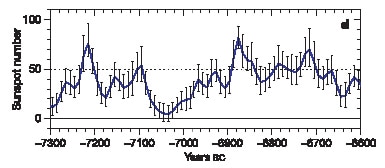The Sun is more active at present than it has been for over 8000 years according to a new method for determining the level of sunspot activity in the past. Sami Solanki of the Max Planck Institute in Katlenburg-Lindau and colleagues in Finland, Germany and Switzerland have developed a technique that relates the number of sunspots to the concentration of carbon-14 in tree rings. However, the team insists that this high level of solar activity is unlikely to be the main cause of global warming (Nature 431 1084).

Sunspots are produced by magnetic activity inside the Sun. Observations of sunspots began in 1610 — soon after the telescope was invented — but no other data exists from before this time. Last year, Solanki and co-workers used the concentration of beryllium-10 in polar ice as a proxy for historic levels of solar activity but their reconstructions only went back as far as 850 AD. Now carbon-dating has enabled them to go back 11,400 years in time.
Carbon-14, like beryllium-10, is produced when cosmic rays interact with particles in the Earth’s atmosphere. The radioisotope is then converted into carbon dioxide and is stored in tree rings as they form. The Sun’s magnetic field can deflect cosmic rays away from the Earth, so a stronger field leads to less carbon-14, and vice versa. Using carbon-14 data Solanki and colleagues found that there has been a sharp increase in the number of sunspots since the beginning of the 20th century. The new results agree with their previous findings based on beryllium-10 (figure 1).
The calculations also showed that there have been three prominent periods of high sunspot number — with the average number exceeding 50 — in the last 11,400 years. These occurred mainly before 6000 BC (figure 2). However, the present value of about 75 sunspots is the highest ever recorded in the last 8000 years. According to the team, this period of unusually high activity has lasted for an abnormally long time and should end within 50 years.
Despite the high level of solar activity we are currently witnessing, Solanki and colleagues say that man-made factors are responsible for current global warming. Climate models have shown that solar activity can only account for 30% at most of the global warming experienced since 1970.




